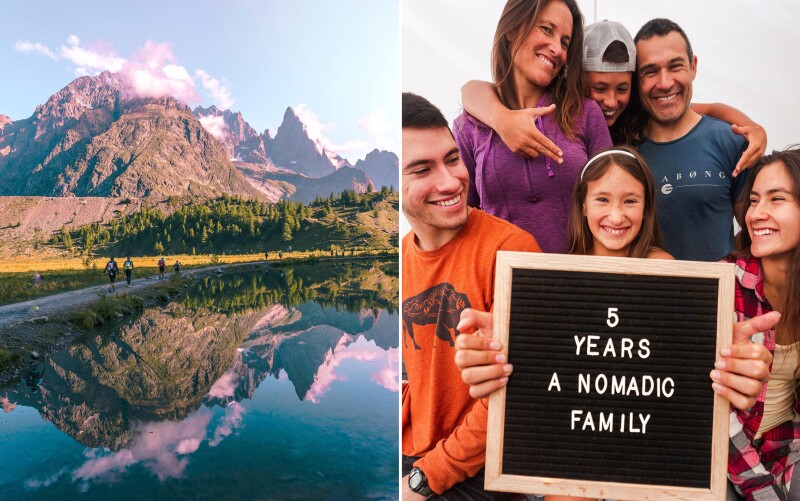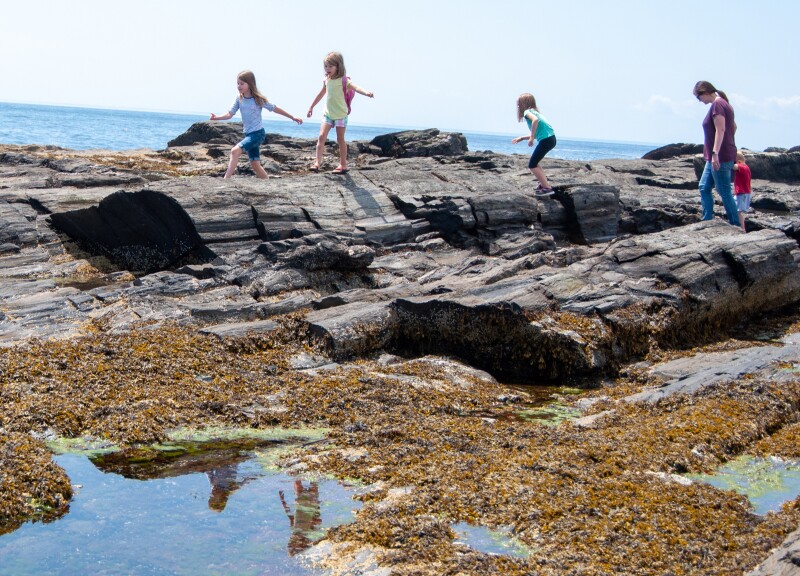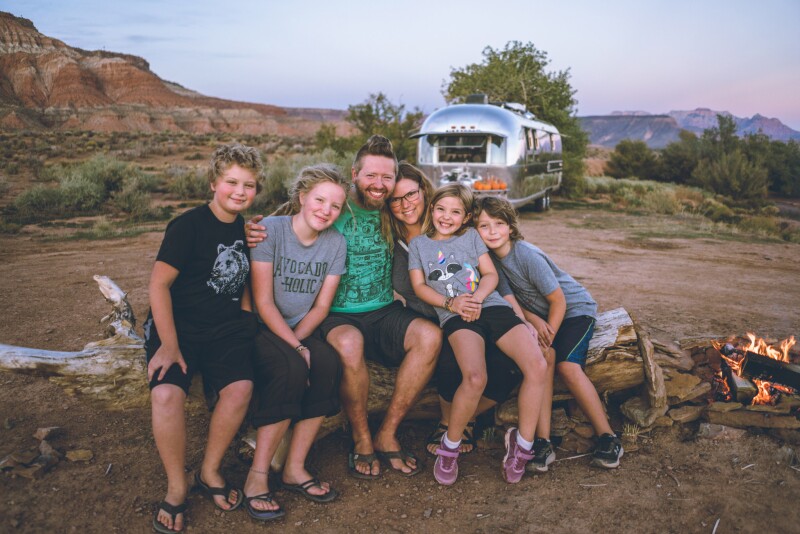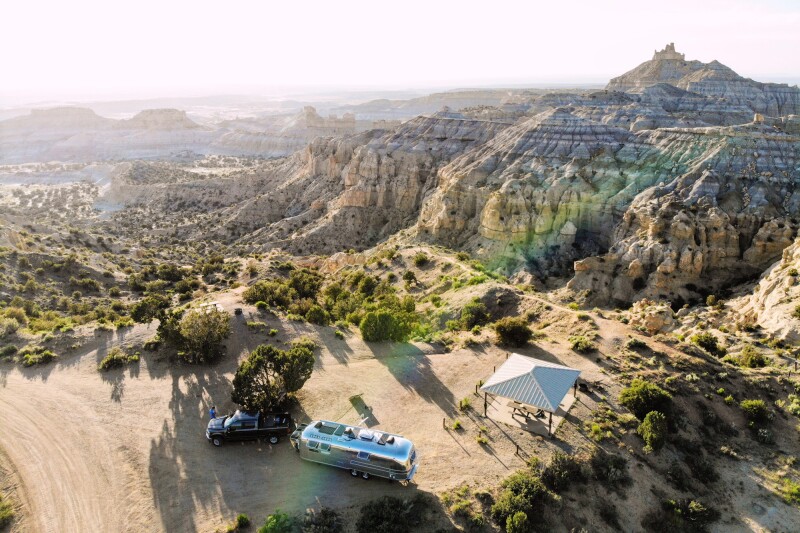By early 2015, Robyn and Victor Robledo had checked all of society’s invisible boxes. They’d been married for 18 years and had five healthy, active children between the ages of 4 and 15. They ran a business together, a gymnastics and personal-training facility called Island Tumble. The family lived in Chula Vista, California, across the bay from San Diego, in a 3,000-square-foot house with a two-car garage, a backyard barbecue pit, and an outdoor pool with a waterslide. It had previously been a show house; a model of life lived well.
Something, though, was missing. Something, in the Robledos’ successful, sun-kissed lives, felt empty.
“I remember sitting on the beach with my husband,” Robyn Robledo says, “and I’m like, ‘I never see you. We’re still this much money in the hole. And all I want to do is sit on a beach and surf some waves. So what the heck’s the point [of living this way]?’”
Three months later, the Robledos turned their lives upside down. They sold nearly everything they owned, pulled their kids out of school, bought a 30-foot RV, and hit the road. Over the next two years, they drove through the American West, explored a dozen European countries, and went surfing on three continents. In 2017, they shuttered their California business and made a “great leap of faith,” according to their website, Nomads With a Purpose, to “go all-in on this epic journey” and become a full-time traveling family.
In the years since, the Robledos—whose stated mission is “To live each day in search of adventure, together as a family, and to inspire you to find your purpose so you can live your life to the fullest”—have spent just five months living in a “stick and bricks” home. After their RV was badly rear-ended in 2018 (and, in the end, “totaled” by their insurance), they temporarily moved into a house in Colorado, then upgraded to a 42-foot fifth wheel and began traveling again. As they put it on their website: “Some of us hated living in a house.”

The Robledos shuttered their family business in 2017, and live out of a 42-foot fifth wheel.
Photos by Gabi Robledo
A Growing Movement
For much of the 20th century, full-time travel was the purview of white-collar retirees, people who superimposed the vast stretch of retirement onto the open road. Then, in the early 2010s, coinciding with the launch of Instagram, a new nomadic lifestyle appeared: vanlife. Vanlife took old-fashioned American values—rugged individualism, a back-to-the-land yearning, the bohemian desire to exist outside the cookie-cutter 9-to-5 life—and commodified them for social-media consumption. What had been a countercultural lifestyle a half-century before was now an enviable, aesthetically minded “brand” propagated on social media by attractive, childless wanderers.
“But, for all its twee escapism,” Rachel Monroe wrote in The New Yorker in 2017, “vanlife is a trend born out of the recent recession.” Like those who fled the Dust Bowl during the Great Depression, van-lifers sought a circumstantial escape from financial precariousness. Full-timing promised a similar escape, but the lifestyle arose from the what-ifs that dogged those who emerged from the crisis relatively unscathed: What if we never had to pay another mortgage? What if we worked when and how and where we wanted? What if our children could be educated by the world at large? What if that retiree trope of “enjoying life while we can” meant enjoying life right now?
RV ownership, which now stands at 11 million American households, has surged over the last decade, driven by growing interest from young people. The average age of RV owners fell from 48 in 2011 to 45 in 2016, and is dropping still; Generation Xers now have a higher RV ownership rate than Baby Boomers. More than a million Americans live full time in RVs, according to the RV Industry Association, and search data for terms like “full-time RV” and “RV living” show that the internet hive mind is attuned to the trend.
“There were a lot of people full-timing who you just didn’t know about before social media,” says Robledo. “Now, it’s FOMO, like, ‘Oh, I want to jump on that.’”

Many full-timing families got their start after feeling hollowed out by working a 9-5.
Photo by Rota Alternativa/Unsplash
“More Freedom, More Adventure”
Jessica Meinhofer and her husband, Robert, along with their two children, used to live in a low-slung 2,000-square-foot house in Florida. She worked from home as a government contractor, he worked an office job in human resources, and together they felt hollowed out by the monotony of suburbia. When Robert was offered a job in Atlanta with a flexible four-days-on, four-days-off work schedule, they took it as a sign. In late 2015, they bought a pickup truck and a 250-square-foot travel trailer and switched the focus of their nascent YouTube channel, Exploring the Local Life, from local finds to full-timing.
“A lot of people feel that having a big house and cars and toys, all these material things, is kind of freeing,” says Meinhofer. “But I think the American Dream is actually one of freedom.” After five years on the road, she says, “I’m not like, Oh, I want that 44-foot whatever, or the huge—no, no. The ‘more’ I want is to explore more. More freedom, more adventure.”
“A lot of people feel that having a big house and cars and toys is kind of freeing. But I think the American Dream is actually one of freedom.”
Full-timers explain their rationale for living life on the road in strikingly similar ways. Whether they were living to work or working to live, they were working, simply, too much. Money wasn’t buying them happiness, and it certainly wasn’t affording them more time with their kids. So they chose to “follow [their] passions,” to “focus on what’s truly important,” to go “against the grain” and “break the mold,” to “live freely, without regrets.”
Reid Fuller had been living in Tennessee with his wife, Hilarye, and their four children, in a house they’d outgrown. They were looking for a new house when Fuller’s father passed away. The loss made Fuller realize that what he wanted wasn’t more space, necessarily, but more time with his family. The six of them loved traveling together, and Fuller had seen people online talk about full-timing, so . . . why not?
“We figured that if we were on the road together, it would allow a lot of quality time, growth, and fun experiences,” says Fuller, who made the switch in April 2018 and blogs at Dotting The Map. “More than we’d get being, y’know, stationary.”

Hilarye Fuller and her four children spend some time away from their RV.
Photo by Dottingthemap.com
The Income Factor
There are many myths that surround families who travel full time. One is that they’re on permanent vacation. (“I honestly don’t know how much our friends and family realize how hard we work to be self-sustaining, because it can appear that we’re playing all the time,” Fuller says.) Another myth is that they’re lonely or antisocial, finding comfort only in the outdoors and in each other. (Fuller again: “You can have as much or as little a social life as you want.”) Still, the most pervasive misconception of full-timers concerns money: that they’re either rich or poor, either gallivanting through an endless summer on a trust fund or unable to afford a “real” home. But money, whether a surplus or a surfeit of it, is rarely a primary factor. Many full-timers had been living comfortably, at least in a material sense, before hitting the road. Besides, the lifestyle is more expensive than you’d think.
“A lot of folks believe life on the road is cheaper, but it’s just a different way of spending your money,” says Jill Denkins, who runs Fulltime Families with her husband, Dustin. There’s no such thing as free land for RVers, save for the occasional overnight in a big-box store’s parking lot, and most campgrounds and RV parks charge $25 to $50 a night. With RVs getting single-digit mileage, fuel can cost upwards of $500 a month, and regular RV maintenance (oil changes, tire repairs, propane-tank refills, water-pump replacements) adds another $100. Meinhofer has heard people brag about full-timing on as little as $1,500 a month, but on that money, she says, “You’re not doing much exploring. You’re probably spending a lot of time parked somewhere in the desert or the woods.” She adds, “It always costs more than you think it’s going to cost.”

Jonathan Longnecker and his family spent six months renovating an Airstream for off-grid living.
Photo by Tiny Shiny Home
In both the simple facts of their lives and how they choose to live them, full-time families are as diverse as the landscapes they traverse. (Though not racially—like vanlifers, a majority of full-timers are white.) They live in luxurious, bus-sized motorhomes, or in small RVs built on a van chassis, or in fifth-wheel campers towed by pickups. They scratch their “hitch itch” by driving somewhere new every week or two, or they settle down for months on end. They plan their travels for the rest of the year, rigorously checking off bucket-list items, or they move about spontaneously, chasing sunshine or snow. They boondock in the wilderness, off the grid and with no hookups, their RV powered by solar panels or an onboard generator, or they congregate at RV parks and well-appointed campgrounds.
And with a coterie of Wi-Fi hot spots, cellular-signal boosters, and phones on each mobile network, they do any and every job that’s flexible enough to allow remote work, often cobbling together incomes from multiple sources. For a few months in 2018, Meinhofer and her husband worked 24 hours a week as campground hosts at a Georgia state park; since her government contract ended last fall, she’s been focused on monetizing Exploring the Local Life and researching remote gigs on Workamper News, an employment resource for RVers that’s been around since 1987. Robledo and her husband make money from affiliate links on Nomads With a Purpose and also run online personal-training sessions. Fuller is a freelance designer and photographer; his wife sells essential oils, and the two of them have investment properties and teach English online. “We’ve met people who do just about everything remotely,” he says. “It’s crazy.” What unites full-time traveling families is what separates them, literally, from the rest of America: Their house is on wheels, and it’s most likely much smaller than yours.
“We’ve met people who do just about everything remotely. It’s crazy.”
Indeed, most full-timers say their greatest challenge was the initial house-to-RV adjustment. Beginnings are always hard, and harder still when they involve downsizing one’s life in the hopes of making it feel bigger. With space at the most premium of premiums, families are forced to adopt a minimalist’s mindset.
In time, though, family life in an RV doesn’t look much different from that in a house, and severe space limitations can foster creativity. Books, board games, and puzzles are popular diversions. On the full-timing subreddit, which has nearly 6,000 members, one full-timer shared a picture of her Christmas-day setup: a looping Netflix video of a crackling fireplace on the wall-mounted television.

One of the Robledos’ five children plays guitar in their fifth-wheel RV.
Photo by Gabi Robledo
Welcome to Roadschooling
Full-timing parents don’t often use the word “homeschooling,” wary of conjuring that dated image of a lonely child doing multiplication tables beside a harried mother. Instead, they prefer terms that suggest their lifestyle’s contrarianism and geographic expansiveness: “roadschooling,” “roamschooling,” “worldschooling,” and even “unschooling,” in which children are completely self-directed. Roadschooling often employs elements of a standard academic curriculum, but it prescribes to the idea that children learn best on their own terms, following their interests with body and mind. Anything learned while traveling, the thinking goes, falls under the shadow of roadschooling; life, then, is education. The Meinhofers’ list of educational activities includes “Go on a scavenger hunt in the woods,” “Journal,” “Visit a historic downtown,” “Play Words with Friends,” “Study a thunderstorm,” and “Measure everything!”
Jonathan Longnecker was running a small web-design agency from home and homeschooling his four children with his wife, Ashley, when he learned that a friend had just sold his house to travel full time in an RV. “It had never occurred to me that you could do that,” he recalls. “Especially a family with kids.”
Full-timing, Longnecker thought, would be “a really great adventure.” But it also seemed to be the answer to two questions that had been weighing on him and Ashley: “How can we educate our kids and put them in situations that most other kids won’t have the opportunity to experience? How can we live more intentionally?” In the spring of 2015, the Longneckers sold their house in Tennessee and used that money to buy a 37-foot fifth wheel and a pickup truck to tow it; after a year, they sold their fifth wheel and bought a 1972 Airstream, which they completely renovated for off-grid living.
“How can we educate our kids and put them in situations that most other kids won’t have the opportunity to experience? How can we live more intentionally?”
Like many full-timing parents, the Longneckers’ roadschooling is fluid, ranging from “hardcore curriculum stuff” to “hands-on stuff that’s more like unschooling.” Usually, though, mornings are for schoolwork in the Airstream and afternoons for exploratory education outside of it. “If we’re at a national park for a week, that week is all about the history of it, the plants and animals, the science of how it came to be,” Longnecker says.
The greatest challenge for full-timing parents, it seems, is to convince outsiders that their kids won’t end up antisocial, goalless, or illiterate dropouts on welfare, in the case of one comment on the Meinhofers’ YouTube channel. Romantic notions of a wild-and-free childhood aside, full-timing children are just as happy and well-adjusted, their parents argue, as their peers from more traditional backgrounds. If anything, they spend more time with those outside their own age group, learning “empathy by communicating with people who aren’t exactly like them,” Longnecker says. And their socializing, after all, doesn’t look much different than it would in your average American neighborhood. Children visit each other’s campsites, go hiking, and hang around the RV park’s pool—or, in many cases, go online, maintaining friendships made on the road. Parents do, too.

With roadschooling, state and national parks are an informational playground.
Photo by Tiny Shiny Home
A Beautiful Day in the Neighborhood
Founded in 2010 as an online magazine for the growing population of RVing families, the organization Fulltime Families has 3,200 lifelong member families who pay $58 a year to participate in the community. Since taking over Fulltime Families in 2018, the Denkinses, who’ve been full-timing with their four children for seven years, have built it into a many-tentacled communal octopus. It’s partnered with various companies to offer discounts on outdoor gear, business-building software, and campground and RV-park fees. It hosts member events across the country, from short field trips and one-day parties to Meetups and Hangouts, which last a few days and are capped at 20 families. Rallies are the highlight of the full-timing social calendar, drawing up to 80 families to raucous weeklong affairs. The yearly Family Reunion Rally has potlucks, bouncy houses, and “Mom and Dad’s night out” at a water park in Florida; at the Balloon Fiesta Rally, hosted every fall in Albuquerque, families have Nerf-gun battles and dance parties beneath a sky filled with hundreds of hot-air balloons. Last year, Fulltime Families hosted 15 events.
As with vanlife, social media powers the full-timing community. But whereas Instagram is van-lifers’ platform of choice, full-timers generally prefer Facebook, home to popular groups like Full-time RV Family Life (12,000 members), Full-time RV Families (19,000), and FULL Time RV Living (75,000). Fulltime Families’ main Facebook group has 35,000 members, in addition to 57 subgroups and 22 “branches” for members who share common interests (fitness, cooking), identities (LGBTQIA+ members and allies), and jobs (IT professionals, traveling tradesmen).
“The fact that there is a community now, and that we all can connect with each other, makes a huge difference in how full-timing is exploding.”
If wanderlust is what drove full-timers to hit the road in the first place, it’s the vibrant community that keeps their wheels turning. In conversation, words like “tight-knit,” “committed,” and “wonderful” are tossed around in dulcet tones. Fuller says that each campground hosting full-timers has “a kind of community feel to it, like a smaller-scale neighborhood.” Denkins calls it “the best neighborhood you will ever live in.”
Online and off, the full-timing community is active—willing to help, willing to rally around a “neighbor.” “If someone breaks down on the side of the road, within an hour there will be someone messaging them to help them out,” Denkins says. “If they’re having surgery and are in the hospital, members will deliver meals.” The Facebook groups are a bottomless fount of information and commiseration. Most questions receive dozens of sincere, helpful replies, and requests for help prompt startlingly quick real-world action.
The first time the Longneckers tried to boondock, in Lake Mead, Nevada, their RV got stuck in the mud. “Stuck stuck—like, a tow truck couldn’t even get to us,” Longnecker says. “But some random people we followed on Instagram were two hours away, and they just drove over and pulled us the hell out.” The Longneckers befriended that family, who then invited them to a community boondock in Canyon Rim, Utah, some 400 miles away. “That chain of events,” Longnecker says, “really sort of set us on the path that we’re on now,” deepening his commitment to an itinerant existence. “The fact that there is a community now, and that we all can connect with each other, makes a huge difference in how full-timing is exploding.”

Despite periods of isolation, full-timing families remain connected with others via social media and in-person meetups.
Photo by Tiny Shiny Home
Social Distancing
These are unprecedented times for everyone affected by the coronavirus, not least full-timers. Campgrounds and many government-owned lands have closed, putting travel plans on indefinite hiatus. In early April, Hannah Martin, a digital marketer who’s been full-timing solo since 2016, launched Nomad Parky, a crowdsourced directory of safe places where “displaced nomads” can park their RVs during the pandemic. Forced into sedentary inaction, full-timers have taken to using Facebook groups as a sort of Nextdoor, supplanting face-to-face conversations with digital chitchat. “Looking at the map for weekend travel ideas,” reads the caption on an RV floorplan. “How long is the social distancing supposed to last?” asks another cheeky post. “My wife keeps trying to get in the RV.”
“Our life has changed a lot,” Fuller says with a sigh. “We’re not going out and being tourists right now, which is a huge bummer—that’s one of the main things that we’re out here to do.” His family had planned to spend a week in March at Daytona Beach, but for now they’re “shut down” at a campground in Orlando, where they can do little more to clear their heads than go on cautious walks. He suggested, however, that full-timers have two advantages over their sticks-and-bricks brethren: They already homeschool their children, and they already work remotely. “So we’ve got that figured out,” he says. “Sort of.”











